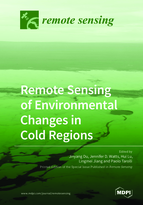Remote Sensing of Environmental Changes in Cold Regions
A special issue of Remote Sensing (ISSN 2072-4292).
Deadline for manuscript submissions: closed (31 July 2019) | Viewed by 48374
Special Issue Editors
Interests: quantitative remote sensing of land surface parameters, including landscape freeze/thaw state; vegetation water content; soil moisture and snow water equivalent for global environmental change studies
Special Issues, Collections and Topics in MDPI journals
2. The Spatial Science Center, Montana State University, LJH 202, Bozeman, MT 59717, USA
Interests: global wetlands; arctic-boreal regions; remote sensing
Interests: microwave remote sensing; soil moisture; land surface data assimilation; hydrological model; climate change
Special Issues, Collections and Topics in MDPI journals
Interests: microwave emission model; snow and soil parameters retrieval; climatic and environmental change; land surface modelling
Special Issues, Collections and Topics in MDPI journals
Interests: digital terrain analysis; earth surface processes analysis; natural hazards; geomorphometry; lidar; structure from motion; Anthropocene
Special Issues, Collections and Topics in MDPI journals
Special Issue Information
Dear Colleagues,
Cold regions including the northern high latitudes, polar regions, and Tibetan Plateau are highly sensitive to global warming and are undergoing dramatic changes in ecological, hydrologic, and climatic processes. Yet, studies of these regions are restricted by their limited in-situ measurements, and remote sensing provides key supports for monitoring and interpreting the on-going environmental changes.
We are pleased to announce a Special Issue of the journal Remote Sensing on “Remote Sensing of Environmental Changes in Cold Regions”. We solicit manuscripts focusing on, but not limited to, the following topics:
- Long-term monitoring of the dynamic changes of air temperature, glacier, snow cover, permafrost, lake bodies and ponds, river systems, and vegetation. Integration of multi-year and multi-source remote sensing data is highly encouraged;
- Applying emerging remote sensing techniques to the mapping of land surface parameters. We are interested in studies related to SmallSats and CubeSats, Unmanned Aerial Vehicle (UAV), GNSS, and near-nadir SAR and InSAR imaging;
- Investigating the use of current and future satellite missions such as SMAP, SMOS, and SWOT in monitoring hydrological and cryospheric parameters;
- Interpreting massive remote sensing data based on cloud computation and machine learning techniques for cold region studies.
- Pan, C.G.; Kirchner, P.B.; Kimball, J.S.; Kim, Y.; Du, J. Rain-on-snow events in Alaska, and their frequency and distribution from satellite observations. Environmental Research Letters, 2018.
- Kim, Y.; Kimball, J.S.; Glassy, J.; Du, J. An extended global earth system data record on daily landscape freeze-thaw status determined from satellite passive microwave remote sensing. Earth System Science Data, 2017
- Du, J.; Kimball, J.S.; Duguay, C.; Kim, Y.; Watts, J.D. Satellite microwave assessment of Northern Hemisphere lake ice phenology from 2002 to 2015. The Cryosphere, 2017.
- Du, J.; Kimball, J.S.; Jones, L.A.; Watts, J.D. Implementation of satellite based fractional water cover indices in the pan-Arctic region using AMSR-E and MODIS. Remote Sensing of Environment, 2016.
- Du, J.; Kimball, J.S.; Azarderakhsh, M.; Dunbar, R.S.; Moghaddam, M.; McDonald, K.C.; Classification of Alaska spring thaw characteristics using satellite L-band radar remote sensing. IEEE Transactions on Geoscience and Remote Sensing, 2015.
- Liu, Q.; Du, J.; Shi, J.; Jiang, L.; Analysis of spatial distribution and multi-year trend of the remotely sensed soil moisture on the Tibetan Plateau. Science China Earth Sciences, 2013.
Dr. Jinyang Du
Dr. Jennifer D. Watts
Prof. Hui Lu
Dr. Lingmei Jiang
Prof. Dr. Paolo Tarolli
Guest Editors
Manuscript Submission Information
Manuscripts should be submitted online at www.mdpi.com by registering and logging in to this website. Once you are registered, click here to go to the submission form. Manuscripts can be submitted until the deadline. All submissions that pass pre-check are peer-reviewed. Accepted papers will be published continuously in the journal (as soon as accepted) and will be listed together on the special issue website. Research articles, review articles as well as short communications are invited. For planned papers, a title and short abstract (about 100 words) can be sent to the Editorial Office for announcement on this website.
Submitted manuscripts should not have been published previously, nor be under consideration for publication elsewhere (except conference proceedings papers). All manuscripts are thoroughly refereed through a single-blind peer-review process. A guide for authors and other relevant information for submission of manuscripts is available on the Instructions for Authors page. Remote Sensing is an international peer-reviewed open access semimonthly journal published by MDPI.
Please visit the Instructions for Authors page before submitting a manuscript. The Article Processing Charge (APC) for publication in this open access journal is 2700 CHF (Swiss Francs). Submitted papers should be well formatted and use good English. Authors may use MDPI's English editing service prior to publication or during author revisions.
Keywords
- environmental changes
- cold region
- remote sensing
- land surface parameters
- machine learning








